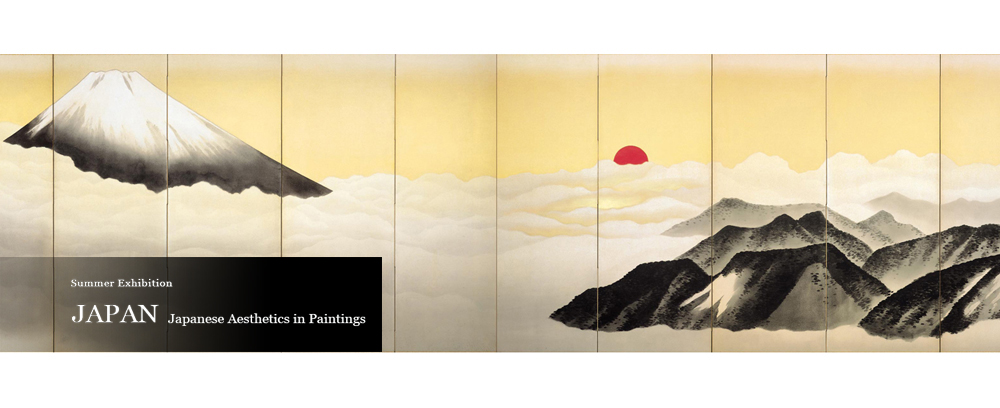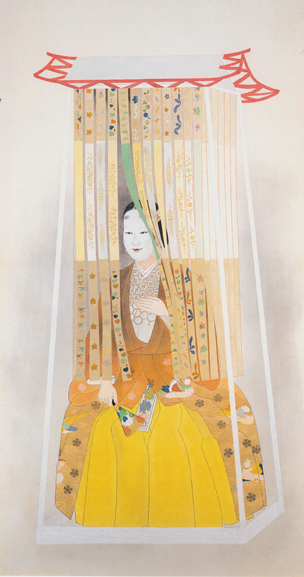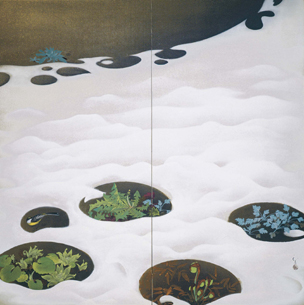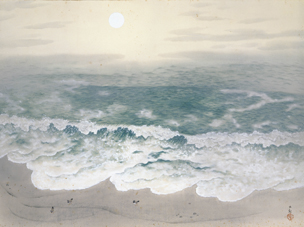
Mt. Fuji|Yokoyama Taikan
Summer Exhibition, 2020 CLOSED
The 50th Anniversary of the Adachi Museum of Art
JAPAN
Japanese Aesthetics in Paintings
June 1 (Mon) – August 30 (Sun), 2020
Over the years, Japan has nurtured its unique culture, including kimono as the indigenous dress and traditional Japanese entertainment, such as noh and kabuki. Today, these traditional art forms have attracted much attention from foreign countries, and Japanese painting is no exception. Many Japanese paintings have taken national culture and nature as subjects. Numerous works have revealed Japanese aesthetics behind various expressions of the transience of falling cherry blossoms and the gentle grace of females, for example, a woman hiding her mouth with the end of kimono sleeve. Through both the beauty of the subject and the Japanese spirit, the Japanese sense of aesthetics can be felt here.
This exhibition will show Japanese paintings that have an atmosphere of Japanese spirit and culture, including Mt. Fuji as the symbol of Japan, cherry blossoms and chrysanthemums as the national flowers, samurai, and women wearing kimono. The tasteful Japanese atmosphere would permeate the minds of the Japanese and others. We really hope that you will appreciate the painting world full of the Japanese spirit.
This exhibition will show Japanese paintings that have an atmosphere of Japanese spirit and culture, including Mt. Fuji as the symbol of Japan, cherry blossoms and chrysanthemums as the national flowers, samurai, and women wearing kimono. The tasteful Japanese atmosphere would permeate the minds of the Japanese and others. We really hope that you will appreciate the painting world full of the Japanese spirit.

Kobayashi Kokei
"Yang Guifei"
(1951)
"Yang Guifei"
(1951)
The Whiteness of Japanese Painting
We will exhibit works focusing on the beauty of whiteness. Some evoke the distinguished whiteness of gofun, a Japanese pigment made from sea shells, and others give the impression of the whiteness made from blank space. For example, pure feathers from egrets and snow accumulating on the branches of camelia trees are beautifully expressed. Please enjoy the gentle, soft whiteness unique to Japanese painting through these expressions.

Kawabata Ryushi
"Sign of Spring"
(1933)
"Sign of Spring"
(1933)
Selected Works from the Taikan Collection --Summer--
Way to Atago, which depicts a path in autumn with a beautiful contrast woven by the blue-green color of pine needles and autumn-colored leaves, and Spring Drizzle, which expresses petals of wild cherry blossoms beaten by the rain and flying in the wind—we will show his works of seasonal, tasteful landscapes.

Yokoyama Taikan
"Autumn: Four Seasons of the Sea"
(1940)
"Autumn: Four Seasons of the Sea"
(1940)

